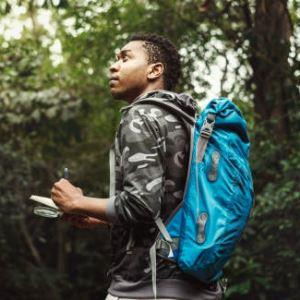 Kakamega Forest Reserve in western Kenya is a prime birdwatching destination for American travelers seeking an immersive experience in nature. This ancient rainforest, the only one of its kind in Kenya, is home to over 450 species of birds, including several that are rare or endemic to the region. Its diversity, beauty, and accessibility make it ideal for Americans looking to explore one of Africa’s richest ecosystems while enjoying a well-organized and eco-conscious tour. Birdwatching tours in Kakamega are designed to provide both comfort and adventure. Guided by experienced local tour experts, these tours take birders deep into forest trails, across swampy wetlands, and along riverbanks where bird activity thrives. With early morning starts and calm pacing, birders can catch sight of species like the Blue-headed Bee-eater, Great Blue Turaco, and African Broadbill. For Americans, these sightings are often lifetime highlights, given how distinct Kakamega’s avifauna is compared to North American birdlife. Tour operators like ours cater specifically to American preferences, offering packages that include airport transfers, eco-lodge accommodations, locally sourced meals, and knowledgeable guides. Travelers can choose from budget-friendly options to premium packages that focus on photography, conservation, or extended stays. Importantly, these packages often include opportunities to engage with the local Luhya community, adding a cultural richness that deepens the experience beyond birding. Eco-tourism is a key focus in Kakamega. Many tours promote sustainable practices such as using solar-powered lodges, supporting reforestation programs, and encouraging plastic-free travel. For American travelers concerned with responsible tourism, these efforts align with global conservation goals and personal travel ethics. Participating in activities like tree planting or contributing to citizen science data makes the journey even more meaningful. Booking a tour from the USA is straightforward. Tour operators typically provide online platforms with secure payment systems, detailed itineraries, and real-time support. The best time to visit is during the dry seasons December to February and June to August when birds are most active and forest trails are accessible. By planning ahead, American birders can ensure a seamless travel experience, with expert guidance every step of the way. With its unmatched biodiversity, local expertise, and strong focus on eco-tourism, Kakamega Forest Reserve delivers an unforgettable birdwatching adventure tailored for Americans. From the forest’s vibrant avian life to its unique ecological makeup, visitors find themselves immersed in an environment that nurtures both discovery and reflection. Whether you are an amateur birder or a seasoned ornithologist, the forest’s rich mix of endemic and migratory species such as the Great Blue Turaco, Turner's Eremomela, and African Broadbill ensures that each visit is full of unique sightings. The guided tours are not just informative, but deeply engaging, allowing visitors to gain insights into bird behavior, habitat conservation, and local ecological practices. Kakamega also offers enriching cultural exchanges with the Luhya community, enhancing the travel experience through local storytelling and traditional practices. For many Americans, Kakamega is not just a travel destination it becomes a meaningful journey into the heart of East Africa’s natural heritage.
Kakamega Forest Reserve in western Kenya is a prime birdwatching destination for American travelers seeking an immersive experience in nature. This ancient rainforest, the only one of its kind in Kenya, is home to over 450 species of birds, including several that are rare or endemic to the region. Its diversity, beauty, and accessibility make it ideal for Americans looking to explore one of Africa’s richest ecosystems while enjoying a well-organized and eco-conscious tour. Birdwatching tours in Kakamega are designed to provide both comfort and adventure. Guided by experienced local tour experts, these tours take birders deep into forest trails, across swampy wetlands, and along riverbanks where bird activity thrives. With early morning starts and calm pacing, birders can catch sight of species like the Blue-headed Bee-eater, Great Blue Turaco, and African Broadbill. For Americans, these sightings are often lifetime highlights, given how distinct Kakamega’s avifauna is compared to North American birdlife. Tour operators like ours cater specifically to American preferences, offering packages that include airport transfers, eco-lodge accommodations, locally sourced meals, and knowledgeable guides. Travelers can choose from budget-friendly options to premium packages that focus on photography, conservation, or extended stays. Importantly, these packages often include opportunities to engage with the local Luhya community, adding a cultural richness that deepens the experience beyond birding. Eco-tourism is a key focus in Kakamega. Many tours promote sustainable practices such as using solar-powered lodges, supporting reforestation programs, and encouraging plastic-free travel. For American travelers concerned with responsible tourism, these efforts align with global conservation goals and personal travel ethics. Participating in activities like tree planting or contributing to citizen science data makes the journey even more meaningful. Booking a tour from the USA is straightforward. Tour operators typically provide online platforms with secure payment systems, detailed itineraries, and real-time support. The best time to visit is during the dry seasons December to February and June to August when birds are most active and forest trails are accessible. By planning ahead, American birders can ensure a seamless travel experience, with expert guidance every step of the way. With its unmatched biodiversity, local expertise, and strong focus on eco-tourism, Kakamega Forest Reserve delivers an unforgettable birdwatching adventure tailored for Americans. From the forest’s vibrant avian life to its unique ecological makeup, visitors find themselves immersed in an environment that nurtures both discovery and reflection. Whether you are an amateur birder or a seasoned ornithologist, the forest’s rich mix of endemic and migratory species such as the Great Blue Turaco, Turner's Eremomela, and African Broadbill ensures that each visit is full of unique sightings. The guided tours are not just informative, but deeply engaging, allowing visitors to gain insights into bird behavior, habitat conservation, and local ecological practices. Kakamega also offers enriching cultural exchanges with the Luhya community, enhancing the travel experience through local storytelling and traditional practices. For many Americans, Kakamega is not just a travel destination it becomes a meaningful journey into the heart of East Africa’s natural heritage.
Comparison of Birdwatching Tour Packages in Kakamega Forest for American Travelers
| Feature | Standard Tour | Premium Eco Tour | Photography Tour |
|---|---|---|---|
| Duration | 3–5 Days | 5–7 Days | 3–6 Days |
| Guide Type | Certified Local Guide | Ornithologist + Local Expert | Bird Guide + Photo Specialist |
| Accommodation | Basic Eco-Lodges | Mid-range Eco-Lodges | Mid- to High-range Lodges |
| Target Species Count | 150–200 | 250+ | 150–180 |
| Sustainable Features | Low | High (solar, waste mgmt) | Medium |
| Price Range (USD) | $450–$750 | $900–$1,400 | $1,200–$1,800 |
| Customization Options | Limited | High | Medium |
| Best For | Budget Travelers | Eco-Conscious Americans | Bird Photographers |
Affordable Birdwatching Packages Kakamega Forest for Americans
Exploring Kakamega Forest doesn’t have to break the bank especially for American travelers seeking value-packed adventures. The region offers an array of birdwatching packages in Kakamega Forest that blend comfort, ecological responsibility, and unforgettable wildlife encounters. Whether you’re a beginner birder or a seasoned enthusiast, there’s a well-priced option tailored to your preferences.
- The Essentials Package (3 Days): This entry-level package is ideal for solo travelers or backpackers on a tight schedule. It includes two nights’ stay in a modest eco-lodge, guided forest walks, and basic birding gear. Meals are provided, and the itinerary focuses on high-yield locations like the Buyangu Hill viewpoint and Lirhanda Hill, where birds are especially active in the mornings.
- The Classic Kakamega Birding Tour (5 Days): A popular mid-range option, this package includes four nights in a comfortable forest-side lodge, daily guided excursions, and transportation from Kisumu. Guests will explore a mix of riverine forest, swamp, and high canopy trails. A bonus cultural visit with the Luhya community introduces birders to traditional forest lore and native conservation practices.
- The Eco-Premium Experience (7 Days): Perfect for travelers focused on sustainability and depth, this premium option features accommodation in solar-powered lodges, gourmet eco-meals, and exclusive access to birding hotspots. Led by both a certified birding guide and a forest ecologist, guests enjoy personalized attention and access to advanced equipment. Night walks and citizen science bird tracking are included for a more in-depth connection with the ecosystem.
- Bird Photography Safari (4 Days): For photography enthusiasts, this specialized tour includes guidance from a professional bird photographer. Timed walks maximize natural lighting, and extra stops are made for framing perfect shots. Lodges are selected for scenic views and proximity to high-traffic bird areas. The package also includes editing sessions and access to a photo-sharing platform.
Each of these birdwatching packages for Americans offers something unique while maintaining a strong value proposition. Whether you want to maximize your sightings, deepen your ecological awareness, or simply enjoy the tranquility of Kenya’s last rainforest, these tours deliver rich experiences for every budget.
Top-Rated Birding Guides in Kakamega Forest Kenya for Americans
The success of any birdwatching expedition hinges largely on the quality of the guide, and Kakamega Forest boasts some of the finest birding experts in Kenya. For American travelers unfamiliar with the region’s dense ecosystem and unique species, the support of a skilled guide transforms a simple walk through the forest into an enlightening and unforgettable experience. These guides are deeply familiar with Kakamega’s terrain, from the towering canopies of Isukuti Hill to the swampy clearings near Yala River. Most have received formal training in ornithology and forest ecology, and many have spent decades studying the calls, behaviors, and nesting habits of the forest’s avifauna. They possess a finely tuned ear for bird calls and a sharp eye for hidden movement skills that make all the difference when searching for elusive species like the Turner’s Eremomela or the Grey-chested Illadopsis. In addition to deep field knowledge, these guides are culturally attuned and able to communicate fluently in English. They understand the expectations and curiosities of American visitors, often tailoring experiences based on birding interests, pace, and photography needs. For bird photographers, they know the best times and lighting conditions to capture rare shots; for amateur birders, they offer patient explanations and easy-to-understand identification tips. What also sets Kakamega’s guides apart is their commitment to conservation. Many are involved in local bird monitoring initiatives, eco-education programs for youth, and community-led habitat preservation projects. When Americans choose a tour led by a certified Kakamega guide, they are not only gaining expert insight but also contributing to sustainable tourism and forest conservation. Whether guiding a dawn walk through the misty undergrowth or leading a full-day excursion across varied forest zones, these guides consistently enhance the birding journey. Their presence offers a reassuring sense of security and enriches the experience with nuanced ecological and cultural insights. American visitors often comment on how these guides help transform a birdwatching tour into a deeply personal journey one filled not just with names and species, but with captivating stories, environmental context, and local traditions that bring the forest alive. The guides are skilled at engaging both beginners and seasoned birders alike, adapting the pace and focus of each tour to individual interests. By the end of the trip, most guests leave with more than just a checklist of sightings. They carry home lasting memories, new friendships, and a profound appreciation for the biodiversity and cultural richness of Kenya’s only rainforest, making the Kakamega birdwatching experience one that resonates long after the final sighting.
How to Book Birdwatching Tours in Kakamega Forest from the USA
For American travelers dreaming of a rich birdwatching experience in Kenya’s Kakamega Forest, the process of booking a tour can be both simple and rewarding with the right guidance. Booking from the USA requires attention to detail, planning, and choosing ethical, professional tour operators who understand both the forest and the expectations of international guests.
- Research Trusted Tour Providers: Start by identifying reputable tour companies that specialize in Kakamega Forest expeditions. Look for those offering customized packages for American travelers, like Homejoy Safari Adventures. Reviews on platforms like TripAdvisor and birding forums help assess quality and guide experience.
- Compare Package Options: Evaluate different birdwatching packages based on duration, species diversity, accommodation quality, and included services like transport, meals, and gear. Many providers offer themed options photography-focused tours, eco-conscious itineraries, or relaxed pacing for older travelers.
- Check Communication and Booking Methods: Choose operators with user-friendly websites, clear package descriptions, and secure online payment options. Reliable operators also offer Zoom consultations or live chat for detailed queries and itinerary customization.
- Book Ahead of Peak Seasons: Kakamega’s best birding months are December to February and June to August. Book at least 2–3 months in advance during these periods to secure preferred dates and accommodation.
- Prepare Travel Documents: Ensure your passport has at least six months’ validity and apply for a Kenyan e-visa through the official government portal. Check if your tour operator offers assistance with paperwork or local travel tips.
- Review Health and Safety Needs: Get recommended vaccinations and travel insurance. Some packages also include options for COVID-19 testing and emergency medical support. Confirm if your lodge or guide follows Kenya Wildlife Service safety guidelines.
- Clarify Airport Transfers and Add-ons: Many birding packages offer airport pickup from Kisumu or Eldoret. Confirm logistics, potential stopovers, and add-ons like cultural tours, extra safari days, or conservation volunteering opportunities.
Booking a birdwatching tour in Kakamega from the USA doesn’t just open a door to avian diversity; it’s an invitation to engage deeply with East Africa’s natural and cultural heritage. With thoughtful preparation and the right guide, it’s a journey that resonates long after the final birdcall.
Birdwatching Safaris in Kakamega for Bird Lovers from the USA
Kakamega Forest Reserve offers more than just a checklist of rare and vibrant bird species; it offers a fully immersive birdwatching safari for travelers from the United States who want to experience African biodiversity in a deeply personal and sustainable way. These safaris are designed with a blend of comfort, ecological awareness, and expert knowledge, making them especially appealing for bird lovers who want more than a casual walk through the forest. With over 450 species recorded, including endemics such as the Blue-headed Bee-eater and the Grey-chested Illadopsis, Kakamega is a haven for serious and recreational birders alike. Safari packages typically start from Kakamega town or Kisumu International Airport, and include full logistical support transportation, permits, lodging, and meals. Guided tours are led by seasoned birding professionals with deep knowledge of the forest and its diverse ecosystems. Americans on these tours benefit from structured itineraries, which allow them to see more birds in a shorter time, and engage with the forest through an educational and conservation-based lens. These birdwatching safaris also include unique add-ons like cultural visits to nearby villages, participation in forest conservation efforts, and night walks to observe nocturnal species. Small group sizes ensure personalized attention and allow for flexibility based on each guest’s interests and skill levels. For photographers, special outings are organized during golden hours, and guides assist with positioning and timing for optimal shots. Most importantly, these safaris emphasize eco-responsibility. Accommodations are typically eco-lodges powered by renewable energy, meals are locally sourced, and waste is minimized through community-led initiatives. American birders increasingly appreciate these elements, recognizing the importance of treading lightly in such a delicate environment. The value of these safaris lies not only in the variety of species observed, but also in the profound emotional and intellectual connection they foster with nature and local communities. Birdwatchers often speak of moments when time seems to stand still whether it’s the brilliant flash of a turaco through the canopy or the rhythmic drumming of a barbet echoing at dawn. These aren’t just birdwatching sightings; they are sensory experiences that leave a lasting impact. What makes the Kakamega safari particularly special for American visitors is its seamless integration of conservation, culture, and adventure. Evenings spent around the campfire with knowledgeable guides from the Luhya community often become highlights, where stories about traditional forest beliefs and modern conservation practices are exchanged. This rich narrative backdrop helps visitors gain a fuller understanding of the ecosystem they are exploring. For many, this journey marks more than just a checklist of exotic species it becomes a personal call to environmental stewardship. As one of the last ancient rainforests in East Africa, Kakamega continues to inspire awe, reflection, and a deep commitment to conservation among all who walk its trails.
Why Book Guided Birdwatching Trips in Kakamega Forest Reserve for US Travelers
For American travelers planning a birdwatching experience in Africa, Kakamega Forest Reserve in Kenya offers one of the most accessible and rewarding guided trips. The forest is home to over 450 bird species, including several that are endemic to the region. Booking a guided trip ensures that visitors don’t just see the birds but fully experience the forest’s magic through expert knowledge, safety, and seamless planning.
- Local Expertise at Your Side: Certified guides have extensive knowledge of the forest’s biodiversity and bird behaviors. Their trained eyes and ears help spot rare species that might otherwise be missed, making the entire outing more successful and educational.
- Customized Experiences for US Travelers: Guided tours are tailored to American preferences from pacing and comfort to interests like photography or conservation. Whether you’re a first-time birder or an experienced enthusiast, guides adjust each tour to match your expectations.
- Seamless Logistics and Safety: Tours include transportation, lodging, permits, and meals, ensuring a stress-free experience. Professional guides are trained in first aid and forest safety, adding peace of mind for international visitors unfamiliar with the terrain.
- Conservation and Cultural Insights: Many guided trips include opportunities to engage with local conservation efforts or interact with the Luhya community. These enrich the birdwatching experience, adding depth through cultural storytelling and environmental education.
- Maximized Bird Sightings: Guides know the best times and locations for sightings, significantly increasing your chances of spotting species like the Great Blue Turaco, Snowy-headed Robin Chat, or the African Broadbill. They also provide field checklists and help identify calls and patterns throughout the forest trails.
Booking a guided birdwatching trip in Kakamega doesn’t just provide access it creates connection. With personalized care, deep ecological understanding, and cultural storytelling, these tours offer Americans a unique way to engage with East Africa’s last remaining rainforest.
Get Eco-friendly Birdwatching Experiences in Kakamega Forest for US Tourists
 Eco-tourism in Kakamega Forest Reserve isn’t just a trend it’s a commitment to preserving biodiversity while offering meaningful experiences to nature lovers. For US tourists, eco-friendly birdwatching in Kakamega is more than spotting rare species; it’s about forging a deeper connection with the natural world and contributing to its protection. Kakamega Forest, as the last surviving tropical rainforest in Kenya, plays host to over 450 bird species, many of which are endangered or endemic. Eco-conscious tours ensure minimal impact on the environment through practices like using solar-powered accommodations, employing local guides, and promoting plastic-free travel. These sustainable approaches are tailored to meet the growing interest among American birders in responsible travel. Tour packages with eco-focus often include activities such as bird counting for citizen science, tree planting with local schools, and guided walks that teach forest ecology. Accommodations are carefully chosen not just for comfort, but for their commitment to conservation. Guests stay in lodges that recycle wastewater, use renewable energy, and source food locally. For US tourists, the experience is enriched by engaging with the local Luhya community. Visitors can enjoy cultural storytelling, traditional dances, and shared meals all while learning about the local relationship with the forest. This cultural inclusion is central to Kakamega’s sustainable tourism model. Choosing eco-friendly birdwatching means participating in a responsible travel system where tourism directly benefits both nature and local communities. When US tourists select tours that reinvest in grassroots initiatives, they help sustain the forest’s fragile ecosystem. These efforts support reforestation, bird habitat preservation, and environmental education for young people in the surrounding areas. At the same time, they boost local livelihoods by creating stable jobs for guides, lodge staff, and artisans, all of whom become stewards of their natural heritage. This model also fosters long-term ecological mindfulness in guests. As travelers witness the positive outcomes of their contributions like seeing saplings planted during a previous season now mature and sheltering birds they develop a sense of responsibility that often extends beyond their trip. Eco-friendly tours offer much more than a scenic experience; they serve as a bridge between conservation and culture. It’s a win for biodiversity, a win for the community, and a significant step forward in promoting global eco-awareness and ethical travel habits.
Eco-tourism in Kakamega Forest Reserve isn’t just a trend it’s a commitment to preserving biodiversity while offering meaningful experiences to nature lovers. For US tourists, eco-friendly birdwatching in Kakamega is more than spotting rare species; it’s about forging a deeper connection with the natural world and contributing to its protection. Kakamega Forest, as the last surviving tropical rainforest in Kenya, plays host to over 450 bird species, many of which are endangered or endemic. Eco-conscious tours ensure minimal impact on the environment through practices like using solar-powered accommodations, employing local guides, and promoting plastic-free travel. These sustainable approaches are tailored to meet the growing interest among American birders in responsible travel. Tour packages with eco-focus often include activities such as bird counting for citizen science, tree planting with local schools, and guided walks that teach forest ecology. Accommodations are carefully chosen not just for comfort, but for their commitment to conservation. Guests stay in lodges that recycle wastewater, use renewable energy, and source food locally. For US tourists, the experience is enriched by engaging with the local Luhya community. Visitors can enjoy cultural storytelling, traditional dances, and shared meals all while learning about the local relationship with the forest. This cultural inclusion is central to Kakamega’s sustainable tourism model. Choosing eco-friendly birdwatching means participating in a responsible travel system where tourism directly benefits both nature and local communities. When US tourists select tours that reinvest in grassroots initiatives, they help sustain the forest’s fragile ecosystem. These efforts support reforestation, bird habitat preservation, and environmental education for young people in the surrounding areas. At the same time, they boost local livelihoods by creating stable jobs for guides, lodge staff, and artisans, all of whom become stewards of their natural heritage. This model also fosters long-term ecological mindfulness in guests. As travelers witness the positive outcomes of their contributions like seeing saplings planted during a previous season now mature and sheltering birds they develop a sense of responsibility that often extends beyond their trip. Eco-friendly tours offer much more than a scenic experience; they serve as a bridge between conservation and culture. It’s a win for biodiversity, a win for the community, and a significant step forward in promoting global eco-awareness and ethical travel habits.






